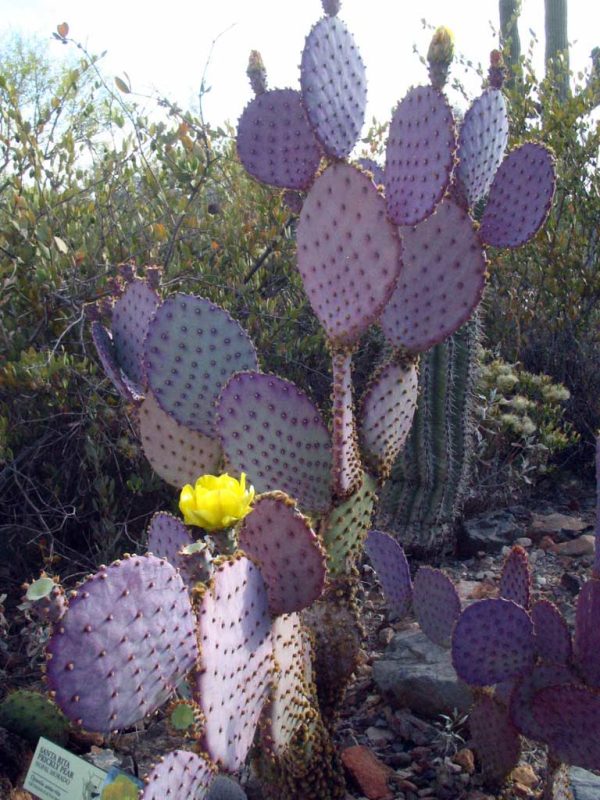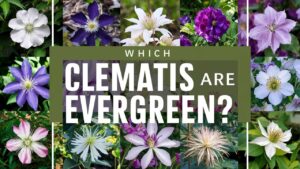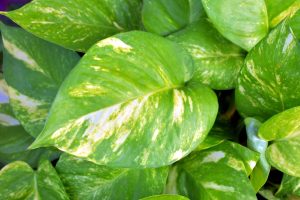Arizona’s arid landscape is home to a remarkable assortment of desert plants, each uniquely adapted to thrive in extreme conditions. From the striking silhouettes of cacti to the vibrant blooms of flowering shrubs, the state’s desert flora is not only visually stunning but also serves essential ecological roles. In this post, we will delve into three particularly noteworthy plants. Each of these species exemplifies the resilience and beauty of life in one of the most challenging environments.
Acacia
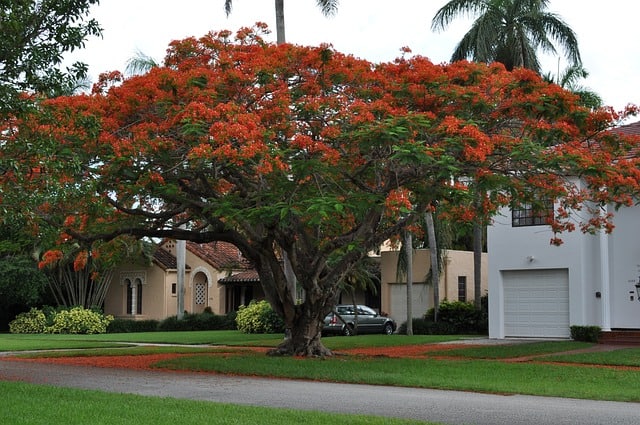
Acacias are a diverse genus of flowering trees and shrubs renowned for their adaptability and ecological significance. In Arizona, several Acacia species flourish, including the famous Acacia Greggii, commonly known as catclaw acacia. This plant is easily recognized by its distinctive curved thorns that resemble a cat’s claw, which are notably effective at deterring herbivores.
The catclaw acacia blooms profusely in the spring, showcasing vibrant yellow pom-pom flowers that attract a myriad of pollinators, including bees and butterflies. Beyond their aesthetic appeal, these plants play a critical role in maintaining desert ecosystems. The dense foliage provides vital shelter for small wildlife, while the nitrogen-fixing capability of Acacias enriches the soil, enhancing the productivity of their surroundings.
Moreover, their root systems are adept at seeking out water from deep underground, allowing them to survive in areas with little rainfall. This attribute is particularly beneficial for adjacent species that may rely on the more extensive root networks of Acacias to access moisture during dry spells. Not only are they valuable for ecological health, but the wood from these plants is also prized for its durability and used in furniture-making and crafting.
Agave
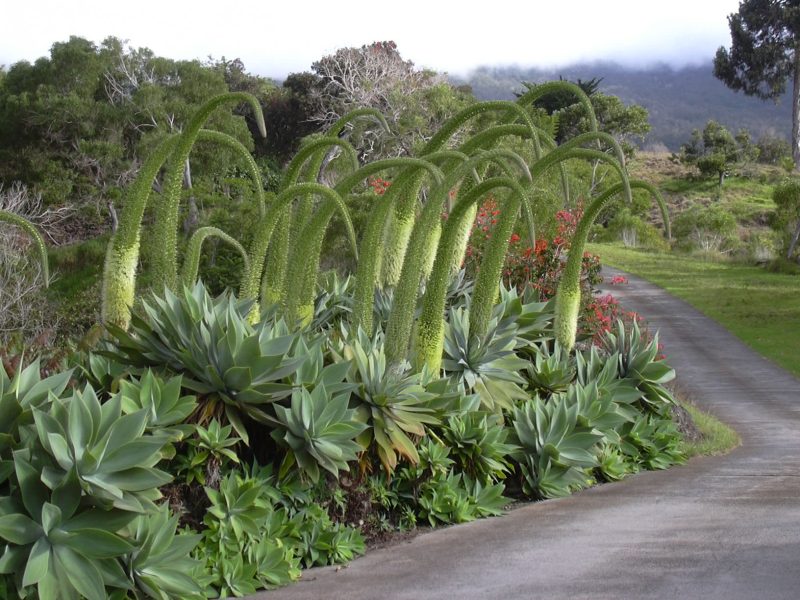
Agave plants are iconic symbols of the Sonoran Desert, celebrated for their striking architectural forms and resilience in the face of adversity. Characterized by fleshy, rosette-shaped leaves and sharp spines, agaves are masters of water conservation. Their leaves are designed to minimize water loss through a process known as CAM (Crassulacean Acid Metabolism), allowing them to photosynthesize during the night when temperatures are cooler to reduce transpiration.
Among the many species found in Arizona, the Agave americana, or century plant, is particularly noteworthy. This large agave can grow up to 6 feet tall and can produce a spectacular flower stalk that can reach heights of 30 feet, displaying clusters of tubular yellow flowers that attract a variety of pollinators, most notably hummingbirds. Interestingly, the term “century plant” stems from the misconception that it flowers only once every hundred years; in reality, it typically flowers after 10 to 30 years, marking the end of its life cycle.
Beyond their botanical interest, agaves hold cultural significance. Indigenous peoples historically utilized the plant for various purposes, including making fibers for textiles and ropes, crafting tools from the spiky leaves, and producing sweet juices that were fermented into alcoholic beverages, like pulque. Today, agave is perhaps best known as the source of tequila, which is derived from the heart of the agave plant.
Aloe
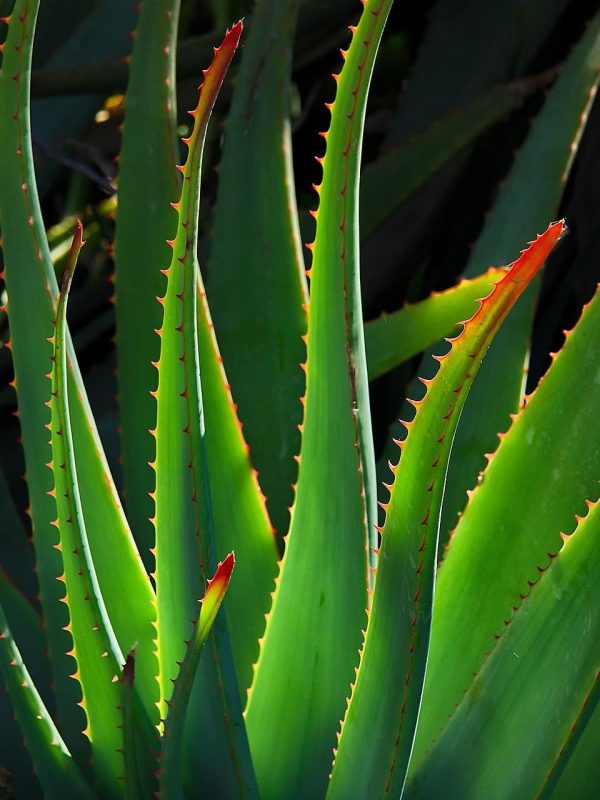
Though often associated with tropical climates, certain aloe species have adapted spectacularly to desert conditions, with Aloe vera being the most well-known. This succulent plant is revered not just for its ornamental qualities but also for its medicinal properties. The fleshy leaves of Aloe vera store a gel-like substance that is celebrated for its soothing effects on skin irritations, burns, and cuts.
In Arizona, Aloes thrive thanks to their ability to endure intense sunlight and endure periods of drought. They employ a specialized water retention system, featuring thick, waxy cuticles to minimize moisture loss and a shallow root system that can quickly absorb rainwater. This adaptability makes them suitable for xeriscaping—landscaping designed to reduce or eliminate the need for irrigation—an increasingly popular choice for homeowners in arid regions.
In addition to their practical uses, Aloes provide ecological value. Their blooms attract pollinators, such as bees and butterflies, playing a vital role in the food web of the desert ecosystem. There are also various ornamental aloe species that offer an array of colors and forms to delight gardeners and nature enthusiasts alike. Planting these hardy succulents adds visual interest to landscapes while promoting biodiversity in water-scarce environments.
Caesalpinia (Bird of Paradise)
Caesalpinia, specifically Caesalpinia gilliesii, shines as one of Arizona’s most striking desert plants, often referred to as the Bird of Paradise due to its eye-catching flowers. This deciduous shrub, native to South America but well-adapted to arid environments, showcases bright yellow and orange blossoms that bloom profusely throughout the summer, resembling a parrot’s plumage and attracting a variety of pollinators.
What makes Bird of Paradise particularly fascinating is its ability to thrive in poor soil conditions, which is a common characteristic of desert ecosystems. This plant requires minimal irrigation once established, making it a popular choice for xeriscaping and sustainable landscaping. Its thorns serve an additional purpose by deterring browsing animals, allowing the plant to maintain its foliage and blossoms.
Beyond aesthetics, Caesalpinia contributes to soil health. As a member of the legume family, it possesses nitrogen-fixing capabilities, enriching the surrounding soil and supporting other nearby plant species. This ecological contribution makes it not only a beautiful addition to gardens but also a responsible one that fosters a healthy desert ecosystem.
Calliandra (Fairy Duster)
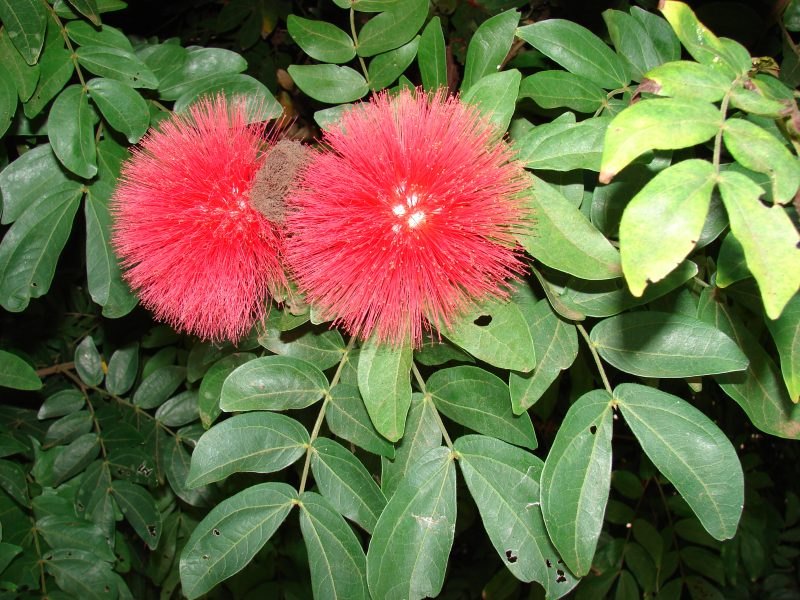
Calliandra, commonly known as Fairy Duster, is a whimsical shrub that captivates with its delicate, fluffy pink flowers that resemble cotton candy. Native to the arid regions of Arizona, this plant is particularly well-suited to desert habitats, often found in sandy or rocky soils. The slender, feathery flower clusters bloom in spring and summer, attracting bees, butterflies, and hummingbirds, thus playing a critical role in supporting local pollinator populations.
Fairy Duster is an impressive example of adaptation to heat and drought. Its finely divided leaves minimize surface area, reducing water loss through transpiration while effectively capturing sunlight for photosynthesis. Its root system is deep and extensive, allowing it to tap into underground moisture reserves, enabling the plant to survive prolonged dry spells.
In addition to its ecological benefits, Calliandra is often used in landscape design for its unique beauty and low maintenance requirements. It grows well in full sunlight and is tolerant of poor soils, making it ideal for Arizona gardens. Moreover, Calliandra has cultural significance among Indigenous peoples who historically utilized its flowers both for decorative purposes and as a source of a soothing beverage made from its leaves.
Cercidium (Parkinsonia) Palo Verde
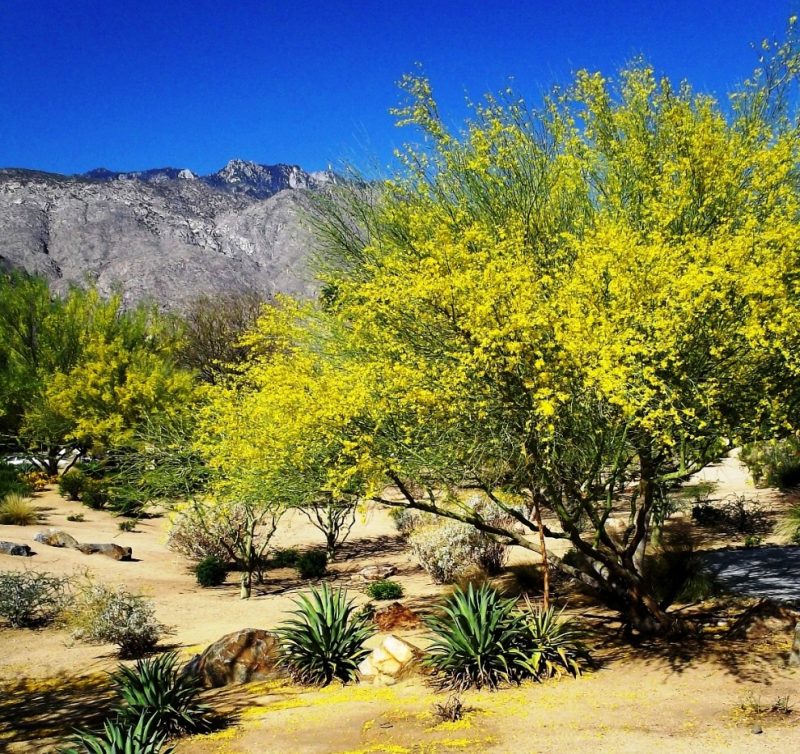
The Cercidium genus, particularly the Palo Verde tree, is an iconic emblem of the Sonoran Desert. Known for its striking green bark and yellow blossoms, the Palo Verde thrives in the harshest conditions. Its name, which means “green stick” in Spanish, aptly describes its unique trunk that performs photosynthesis, allowing the tree to survive even when leaf production is minimal during extreme heat.
There are a couple of notable species of Palo Verde present in Arizona, including the Blue Palo Verde (Cercidium floridum) and the Yellow Palo Verde (Cercidium microphyllum), each adapted to specific ecological niches within the desert. The Blue Palo Verde is celebrated for its lush foliage and vibrant blossoms that herald the arrival of spring, while the Yellow Palo Verde features a more open canopy and smaller leaves.
Palo Verde trees play a vital role in the ecosystem. Their flowers attract numerous pollinators, and their seeds, which emerge in long, flat pods, are an important food source for various wildlife species. Additionally, the shade provided by the trees creates microhabitats that benefit other plants and animals in the desert.
Ecologically, the Palo Verde is also significant for its drought tolerance and ability to enrich the soil. Similar to Acacia species, it has nitrogen-fixing capabilities that improve soil fertility. For gardeners and landscapers, the Palo Verde offers aesthetic value, robust structural interest, and a natural beauty that complements the rugged Arizona landscape.
Chilopsis linearis (Desert Willow)
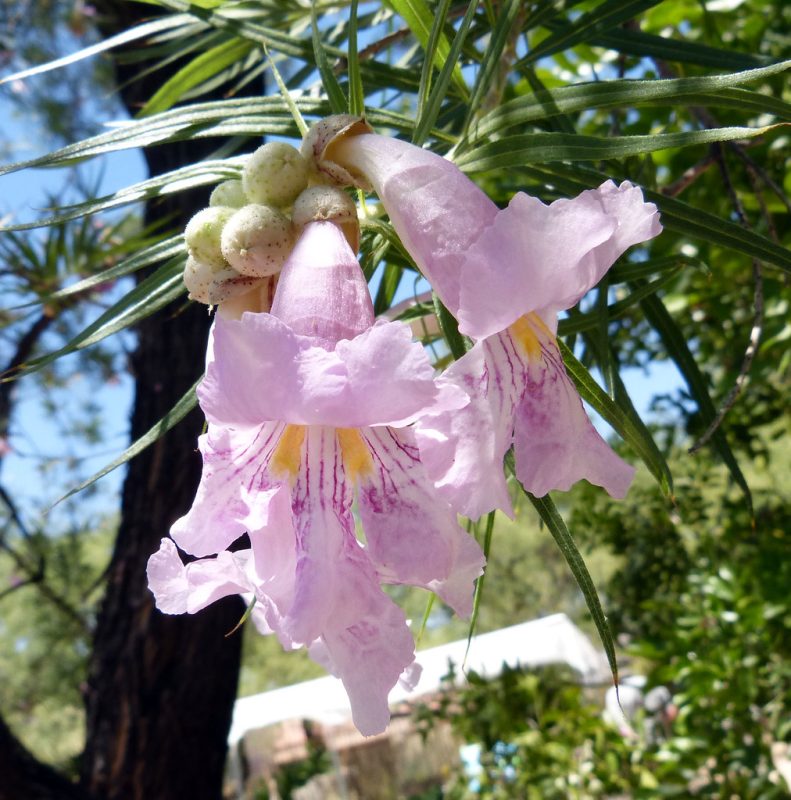
Chilopsis linearis, or Desert Willow, is a deciduous tree that captivates with its stunning trumpet-shaped flowers and graceful weeping branches. This tree is native to the southwestern United States, including Arizona, and thrives in dry, arid areas. During spring and summer, it produces clusters of fragrant pink, purple, or white flowers that attract hummingbirds and various pollinators, making it a vibrant addition to any desert landscape.
One of the Desert Willow’s most notable adaptations is its ability to tolerate prolonged periods of drought. Its deep taproot allows it to access water that is not available to many other plants, enabling it to survive in scorching temperatures and dry soil conditions. The narrow, linear leaves reduce surface area and minimize water loss, a critical adaptation in the harsh desert climate.
In addition to its functional adaptations, the Desert Willow is prized for its ornamental value. It can reach heights of 15 to 25 feet and provides a picturesque shade canopy, making it ideal for residential landscapes. Furthermore, its resilience and low maintenance requirements make it a favorite among gardeners looking to cultivate a drought-tolerant yard.
Dalea
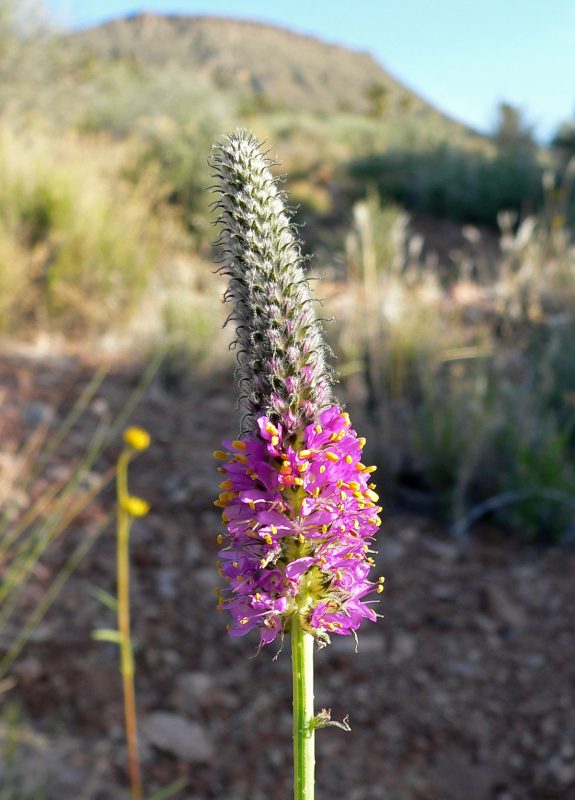
Dalea, also known as Indigo Bush or Purple Prairie Clover, encompasses a diverse group of plants that exhibit vibrant purple or blue flowers. Various species of Dalea, such as Dalea purpurea, thrive in the sandy soils of Arizona’s deserts. Known for their drought resistance and nitrogen-fixing capabilities, these plants play a significant role in improving soil health.
Dalea’s unique flowers grow in dense clusters, attracting a wide range of pollinators, including bees and butterflies. The blooming period spans from late spring to early summer, providing much-needed food for pollinators at a critical time of year. Additionally, the foliage of Dalea boasts a delicate, fern-like appearance, adding a fine texture to desert gardens.
One remarkable aspect of Dalea species is their adaptive strategies for thriving in extreme aridity. They have deep taproots that not only anchor the plants but allow them to access moisture from deep underground during drought conditions. Their resilience to heat and low water availability makes them a popular choice for xeriscaping and water-smart landscaping.
Beyond their ecological benefits and charming appearance, Dalea plants have historical significance tied to Indigenous cultures in the region, where they have been utilized for medicinal purposes and as sources of dye and fiber. Planting Dalea in gardens not only enhances biodiversity but also pays homage to the rich cultural heritage of the desert.
Eremophila
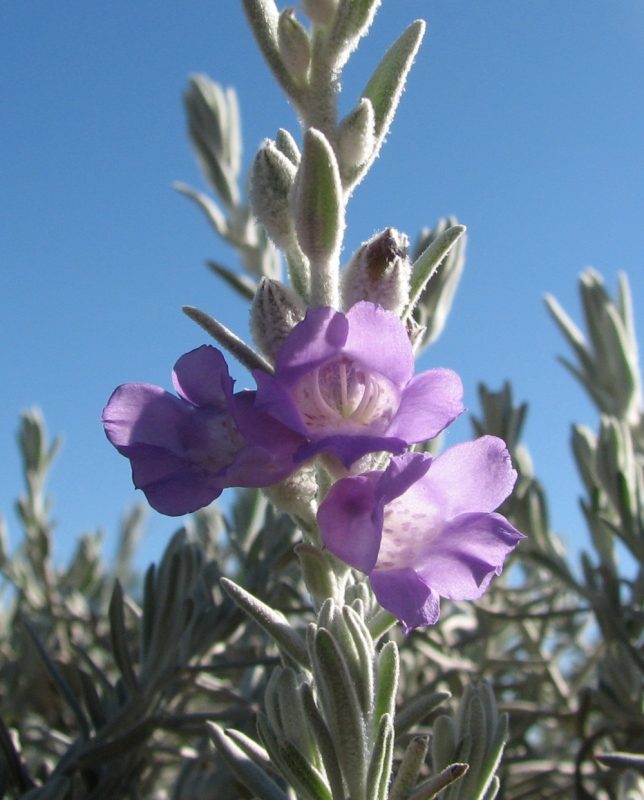
Eremophila, commonly referred to as Emu Bush, is a unique genus of plants native to Australia that have made their way into desert landscapes in the southwestern United States, including Arizona. Renowned for their resilience and adaptability, Eremophila species are well-suited to harsh desert conditions, often thriving in sandy, well-drained soils under extreme heat.
These resilient shrubs feature elongated or elliptical leaves that serve as an adaptation to minimize moisture loss, making them ideal for regions subject to periodic drought. Flowers of Eremophila are often tubular, appearing in vibrant colors such as purple, pink, and yellow, and are primarily pollinated by birds and insects. The blooms typically occur in spring, adding a burst of color to the desert landscape.
Eremophila plants have additional ecological benefits; their ability to stabilize sandy soils makes them valuable in erosion control, contributing to the health of local ecosystems. Moreover, these shrubs are often utilized in restoration projects and natural landscaping due to their low water requirements and ability to thrive in unfavorable conditions.
Gardeners are increasingly recognizing Eremophila’s ornamental potential, as several species can be used effectively in xeriscapes and rock gardens. They provide not only beauty but also habitat for various native pollinators. Additionally, many Eremophila species are deer resistant, making them an attractive option for those looking to minimize the landscape impacts from wildlife.
Ebenopsis ebano (Texas Ebony)
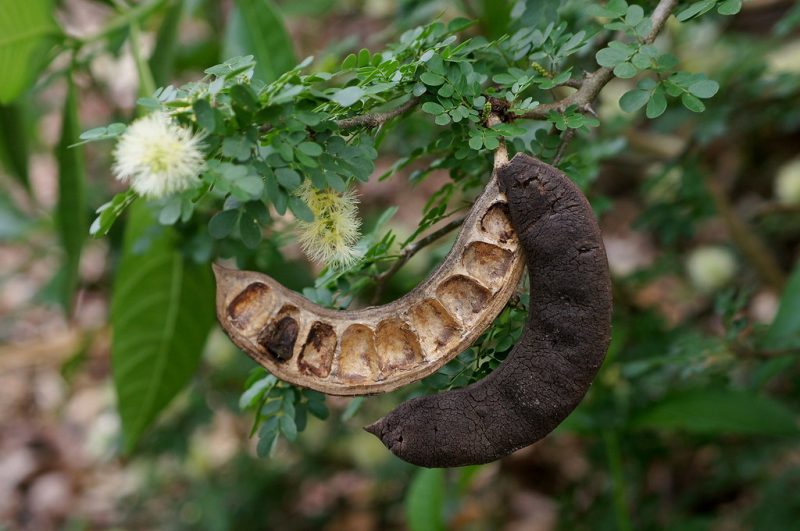
Ebenopsis ebano, or Texas Ebony, is a beautiful, evergreen tree that can grow up to 30 feet tall, boasting a dense, rounded canopy. Its glossy, dark green leaves are finely divided, giving it a delicate appearance that contrasts with its robust stature. Native to the southwestern United States, particularly in areas with well-drained soils, including southern Arizona, Texas Ebony is well-regarded for its resilience and adaptability in arid conditions.
One of the most notable features of Texas Ebony is its striking purple-black fruits, known as pods, which mature in late summer and contain small, edible seeds. These pods not only contribute to the tree’s visual appeal but also provide food for various bird species and small mammals, thus playing an important role in the local ecosystem. The tree’s flowers, which bloom in the spring and early summer, are fragrant and attract a range of pollinators, including bees and butterflies, ensuring its successful reproduction.
In addition to its ecological contributions, Texas Ebony is valued in landscaping for its drought tolerance and low maintenance requirements. It thrives in full sun and can withstand occasional droughts, making it a favorite among gardeners looking to create water-smart landscapes. The hardwood of the Texas Ebony is also prized for its durability and rich color, often used in furniture and crafts. Planting this tree adds both aesthetic beauty and functional value to desert gardens, while also supporting local wildlife.
Hesperaloe
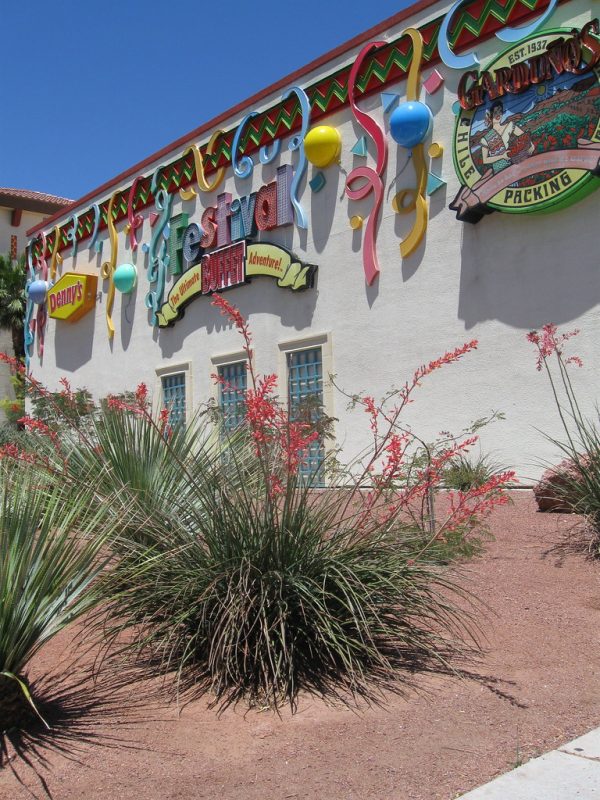
Hesperaloe, commonly known as Red Yucca, is a striking succulent that thrives in the arid landscapes of Arizona. This drought-tolerant plant resembles an agave but belongs to a different family. Its long, narrow leaves form a dense rosette and can reach up to three feet in height. The leaves are evergreen and feature sharp tips, making the plant both beautiful and resilient against browsing herbivores.
One of the most captivating aspects of Hesperaloe is its impressive flowering spikes that can reach heights of six feet or more. In late spring and early summer, tall stems emerge from the leaf rosettes, adorned with tubular flowers that range in color from coral-red to yellow. These blossoms are particularly attractive to hummingbirds and other pollinators, providing a critical nectar source during the blooming season.
Hesperaloe is exceptionally suited for xeriscaping due to its minimal water needs and adaptability to poor soil conditions. Once established, it requires little to no supplemental watering, making it a perfect choice for sustainable gardening in dry climates. Furthermore, it provides dramatic vertical interest in landscape designs, making it a popular plant for borders or as a focal point in rock gardens.
In addition to its aesthetic and functional landscape benefits, Hesperaloe also contributes to enhancing biodiversity by attracting pollinators and birds. With its vibrant blooms and ease of care, cultivating Red Yucca in gardens not only enriches the visual environment but also promotes a lively ecosystem.
Hymenoxys aucalis (Angelita Daisy)
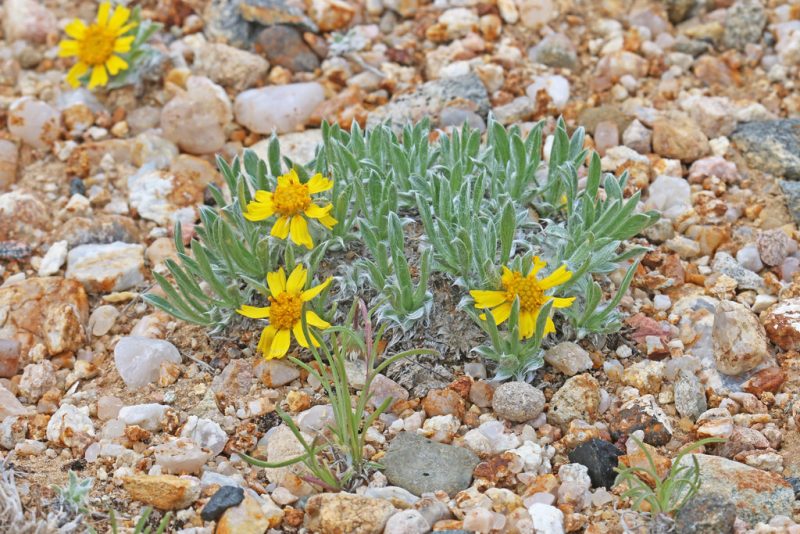
Hymenoxys aucalis, known as Angelita Daisy, is a charming perennial that brings vibrant color to the Arizona desert with its cheerful yellow flowers. Typically growing 1 to 2 feet tall, this hardy plant thrives in the hot, dry conditions typical of the southwestern United States. Flowering predominantly in spring and summer, Angelita Daisy creates a bright display that can cover large areas with its sunny blooms, making it a popular choice for desert gardens.
One of the most remarkable features of the Angelita Daisy is its adaptability to various soil types, including poor or sandy soils, where other plants may struggle to thrive. Additionally, this plant is highly drought-tolerant, making it ideal for xeriscaping projects. Its low-growing habit and spreading nature make it suitable for use in groundcover applications and as an element in rock gardens or mixed plantings.
Angelita Daisy also plays an essential role in attracting pollinators, particularly butterflies, bees, and other beneficial insects. The abundant nectar produced by the flowers helps sustain these critical species, highlighting the importance of flowering plants in maintaining healthy ecosystems.
In landscaping, Hymenoxys aucalis is often used to create colored accents in arid regions, bringing a touch of brightness to otherwise barren spaces. Its resilience and long blooming period make it an excellent choice for gardeners seeking low-maintenance yet visually impactful plants. By choosing Angelita Daisy, garden enthusiasts can enhance their landscapes while supporting the local pollinator populations essential for ecological health.
Justicia (Desert Honeysuckle)
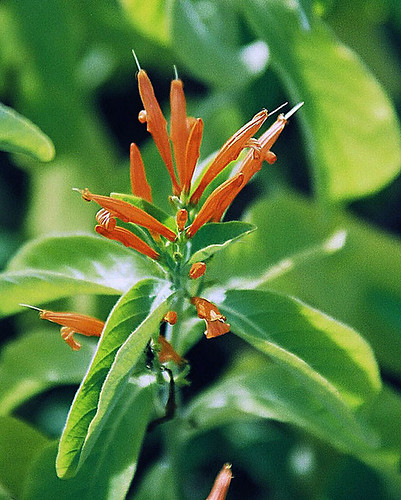
Justicia, commonly known as Desert Honeysuckle, is a stunning flowering shrub that captivates with its tubular flowers and lush green foliage. Native to the southwestern United States and northern Mexico, this perennial plant typically reaches heights of 3 to 5 feet. Its elongated, trumpet-shaped flowers bloom in vibrant hues of orange, red, or yellow throughout the summer and early fall, creating a lush display that attracts hummingbirds and butterflies.
What sets Desert Honeysuckle apart is its adaptability to the desert environment. It thrives in well-drained, sandy soils and can tolerate full sunlight or partial shade, making it versatile for various landscape designs. Its drought tolerance is impressive; once established, it requires minimal irrigation, aligning perfectly with water conservation practices prevalent in arid desert regions.
In addition to its ornamental value, Justicia provides critical habitat for pollinators. The deep nectar-rich flowers are perfectly designed for hummingbird access, which encourages the vital relationship between plants and pollinators in the desert ecosystem. Desert Honeysuckle is a splendid choice for wildlife gardens, enhancing biodiversity while offering beautiful bursts of color that enliven outdoor spaces.
Leucophyllum (Texas Sage)
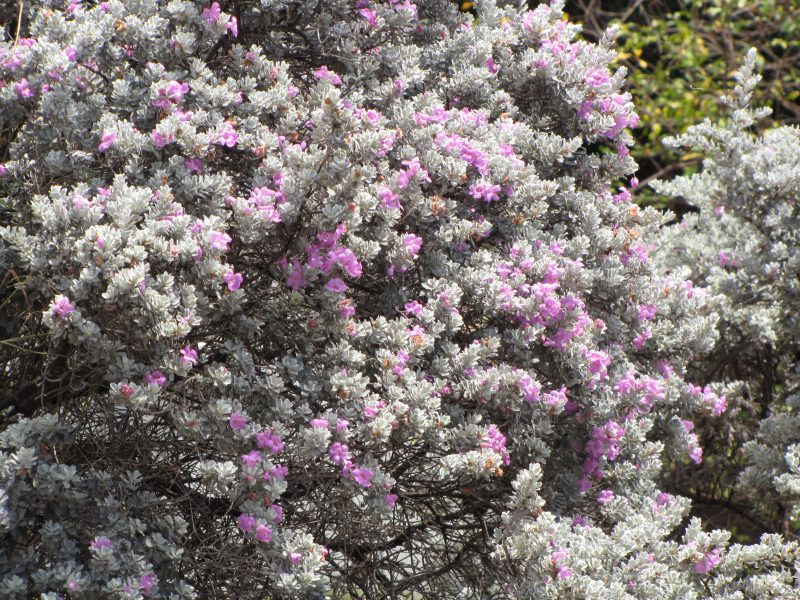
Leucophyllum, commonly referred to as Texas Sage or Barometer Bush, is a beloved shrub known for its silvery-gray foliage and stunning purple flowers. This shrub can vary in size, typically ranging from 3 to 8 feet in height, and is found predominantly in the southwestern United States and Mexico. Texas Sage is highly praised for its ability to thrive in the dry, often unpredictable climate of the desert.
The plant’s leaves are covered in fine hairs, giving them a velvety appearance and enhancing water retention, an essential trait for survival in arid conditions. Texas Sage is also notable for its unique blooming patterns; flowers tend to bloom profusely following rain, earning it its nickname as a barometer bush. The striking purple blooms that appear from late spring to early fall create a beautiful contrast against the plant’s silver foliage, providing visual interest in desert gardens.
Texas Sage is not only drought-tolerant but also extremely low-maintenance. It is well-suited for southwestern landscapes, requiring little to no irrigation once established and thriving in poor soil conditions. Its hardiness makes it an ideal choice for low-water gardens, and it can also act as a natural barrier, with dense growth that can deter unwanted passersby.
Furthermore, Leucophyllum plays a vital ecological role, attracting various pollinators with its fragrant blooms. This makes it an excellent addition to gardens aimed at supporting local ecosystems. With its stunning appearance and ecological benefits, Texas Sage is a favorite among desert gardeners and landscape designers alike.
Muhlenbergia
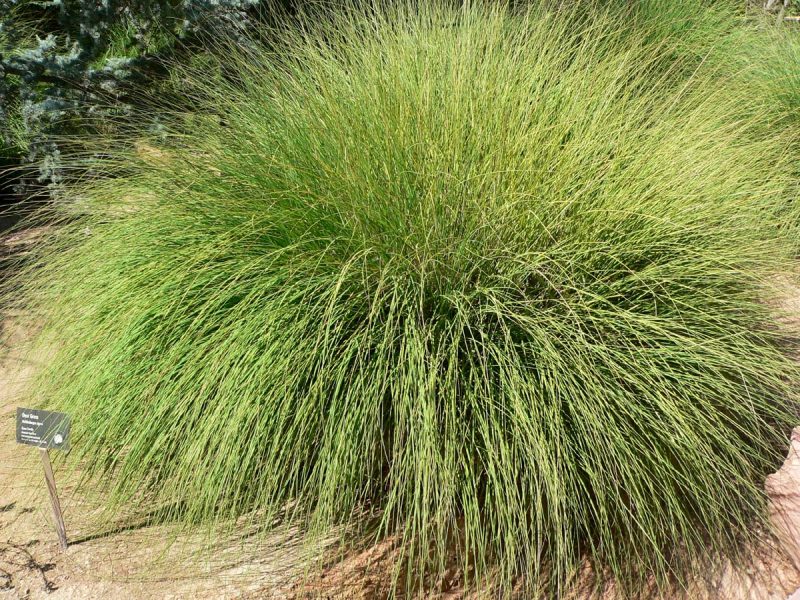
Muhlenbergia, commonly known as Muhly Grass, encompasses a group of ornamental grasses that add texture and movement to desert landscapes. These grasses are characterized by their graceful, arching blades and feathery flower plumes that emerge in late summer and fall. With several species native to Arizona, such as Muhlenbergia rigens (Deer Grass) and Muhlenbergia, this grass thrives in desert environments, showcasing adaptability and beauty.
One of the primary benefits of Muhlenbergia is its ability to endure the region’s challenging climatic conditions. These grasses are exceptionally drought-tolerant, making them a suitable choice for low-water gardens. They can thrive in a variety of soil types, including sandy and rocky soils, and prefer full sun exposure, aligning well with Arizona’s sunny climate.
The soft, airy flower plumes of Muhlenbergia provide visual interest and movement in the landscape, creating a dynamic display as they sway in the breeze. The flowers also attract butterflies and provide cover for wildlife, enhancing biodiversity. As a perennial grass, it requires minimal maintenance and is resistant to pests and diseases, making it a practical choice for gardeners seeking low-care options.
Beyond their decorative appeal, Muhlenbergia species can be effective in soil erosion control, stabilizing banks and slopes with their extensive root systems. They can also serve as windbreaks, helping to reduce soil erosion in exposed areas. By incorporating this elegant grass into desert gardens, homeowners and landscapers can contribute to the health of local ecosystems while enjoying its attractive features.
Oenothera (Evening Primrose)
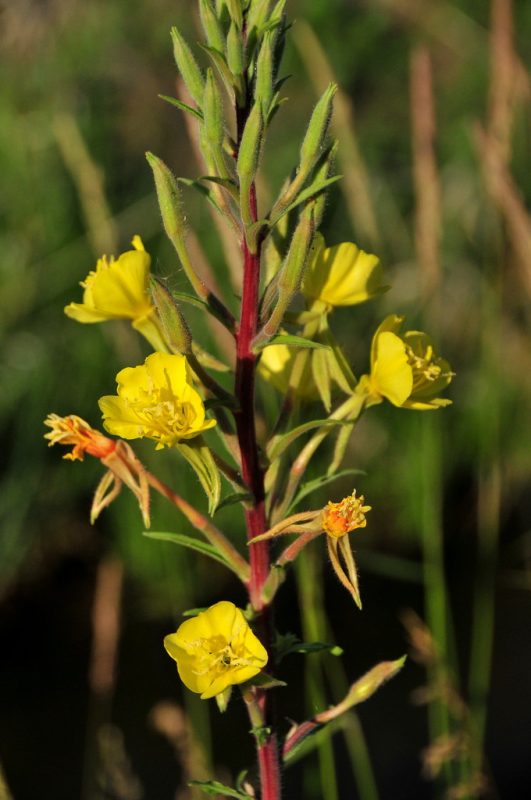
Oenothera, commonly known as Evening Primrose, includes a variety of species native to Arizona that are celebrated for their stunning blooms and night-blooming habits. These perennial plants typically showcase vibrant yellow, pink, or white flowers with four petal-like lobes that open in the late afternoon or early evening, attracting nighttime pollinators such as moths and bats. The contrast of their bright flowers against the backdrop of a twilight desert sky creates a picturesque scene that enchants both locals and visitors.
An intriguing aspect of Evening Primrose is its ability to thrive in challenging desert conditions. It prefers well-drained soils and is resilient to drought, making it an excellent choice for low-water gardens. Once established, these plants require minimal supplemental watering, aligning with sustainable gardening practices. They can grow in a variety of settings, from rocky outcrops to sandy plains, adapting well to different environments.
In addition to their aesthetic appeal, Oenothera plants have ecological benefits. The leaves and flowers serve as food for various pollinators, and the seeds provide nourishment for birds. They also attract beneficial insects that help control pests in the garden. With their enchanting blooms and ecological roles, Evening Primrose plants contribute both beauty and biodiversity to Arizona’s desert landscapes.
Penstemon
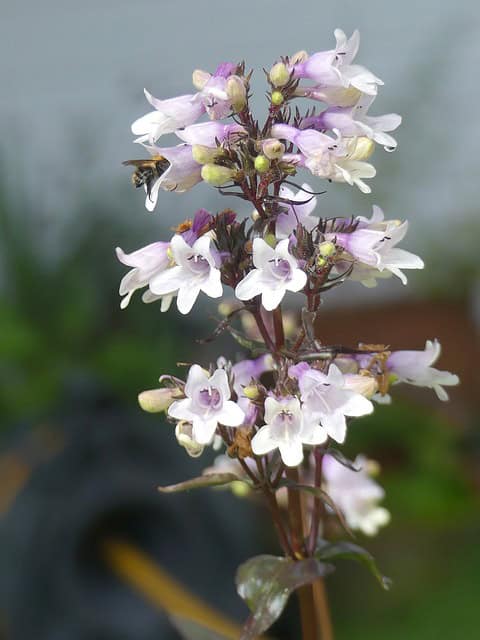
Penstemon, or Beard Tongue, is a diverse genus of flowering plants native to Western North America, with several species well-adapted to Arizona’s deserts. Known for their tubular flowers that come in an array of colors—from deep purple to vibrant red—Penstemon is particularly attractive to hummingbirds and other pollinators, making them a cornerstone of any wildlife-friendly garden.
These perennial plants typically grow between 1 to 3 feet in height, with some species exhibiting lush, green foliage that serves as a backdrop to their spectacular blooms. Penstemon thrives in well-drained soils and is especially suited to rocky or sandy environments, allowing it to flourish in the arid conditions of the Sonoran Desert.
One of the remarkable adaptations of Penstemon species is their extended flowering period, which can last from early spring to late fall, depending on the species and local conditions. This not only provides a consistent source of nectar for pollinators throughout the growing season but also enhances the diversity of color and texture in the garden.
Penstemon is generally low-maintenance, requiring minimal irrigation once established, and can thrive in full sun. Its capability to resist drought makes it a popular choice for xeriscaping, helping to conserve water in landscaping projects. Additionally, its vibrant carpet of blooms can serve as ground cover, beautifying pathways and garden borders while promoting a healthy habitat for local wildlife.
Prosopis (Mesquite)
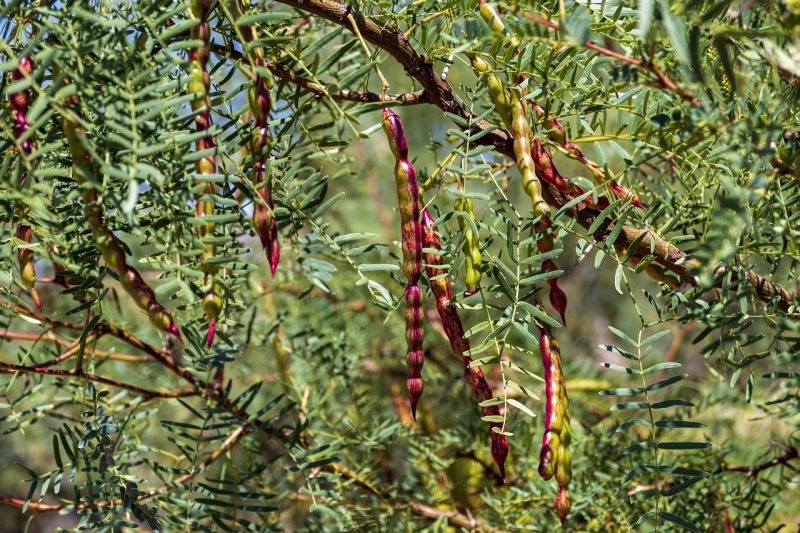
Prosopis, commonly known as Mesquite, includes several species of trees and shrubs that are iconic to the Arizona landscape. Mesquite trees are hardy, native to arid environments, and well adapted to the region’s dry conditions. Their characteristic twisted branches and feathery foliage provide a sense of rugged beauty, and their ability to thrive in poor soils makes them invaluable for sustainable landscaping.
One of the defining features of Mesquite is its resilience; these trees possess deep taproots that can reach water sources far below the surface, allowing them to survive prolonged droughts. Mesquite is also known for its nitrogen-fixing ability, enriching the soil around it and fostering a healthy growth environment for surrounding plants. This symbiotic relationship is crucial in desert ecosystems, where nutrient availability can be limited.
During the warmer months, Mesquite produces fragrant yellow flowers that draw in bees, butterflies, and other pollinators, emphasizing its role in promoting biodiversity. The tree’s pods, which contain sweet, nutritious seeds, serve as food for birds and mammals, further enhancing its ecological importance.
In landscaping, Prosopis offers both functional and aesthetic benefits. Its broad canopy provides cooling shade, making it a valuable asset for reducing heat in outdoor spaces. Mesquite wood is also highly prized for its durability, aromatic qualities, and use in cooking, furniture making, and crafting. By incorporating Mesquite into gardens and parks, landowners can create beautiful landscapes that are also supportive of local wildlife and resilient to the challenges of a desert environment.
Salvia (Sage)

Salvia, commonly known as Sage, is a diverse genus that includes various species well-suited to the desert environment. Arizona residents often favor the native species, such as Salvia dorrii (Desert Sage) and Salvia leucophylla (Purple Sage), for their fragrant leaves and striking flowers. These perennial shrubs typically grow to heights of 2 to 4 feet and bloom profusely during the spring and summer months.
One of the key features of Salvia is its ability to attract a variety of pollinators, especially bees and hummingbirds. The tubular flowers, which can be found in shades of purple, blue, or white depending on the species, serve as a nectar source, playing a crucial role in maintaining the biodiversity of the desert. Their blooms not only bring vibrant colors to the landscape but also contribute to the ongoing life cycles of local wildlife.
In addition to their ecological significance, sages are known for their exceptional drought resistance. Their deep root systems allow them to access moisture even in challenging conditions, while their aromatic leaves help to deter herbivores. This natural resilience makes Salvia an excellent choice for low-maintenance gardens that thrive with minimal water.
Sage plants are also celebrated for their culinary uses. The flavor of sage enhances a variety of dishes and is commonly used in traditional cooking, creating a bridge between the natural world and culinary art. Incorporating sage into home gardens not only adds visual interest and ecological benefits but also provides culinary delights for those who appreciate the flavors of the desert.
Senna (Cassia)
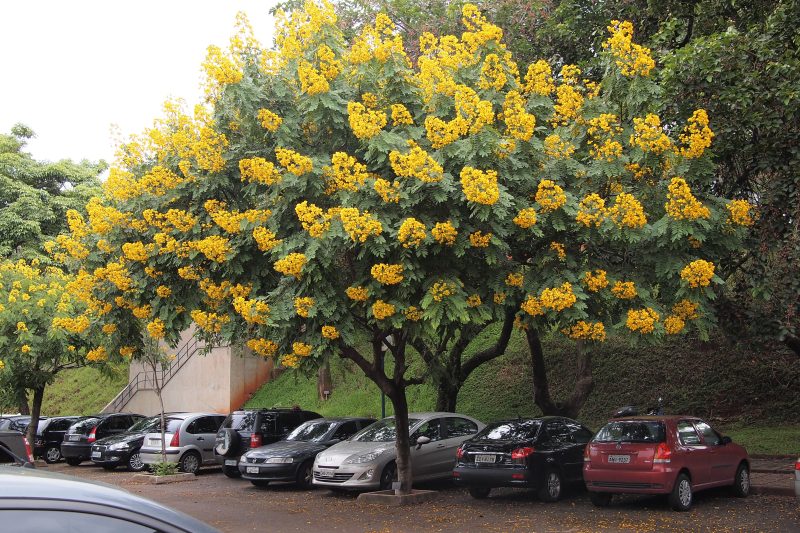
Senna, often referred to as Cassia, encompasses a variety of species known for their beautiful flowers and feathery foliage. Senna species such as Senna hebecarpa, commonly known as American Senna, and Senna spectabilis, or Golden Cassia, are well-suited to Arizona’s climate. With their lush green leaves and striking yellow flowers that bloom in clusters, these plants add a splash of color to the desert landscape during the warmer months.
One of the standout features of Senna is its nitrogen-fixing ability, which plays a critical role in enhancing soil fertility. By converting atmospheric nitrogen into a form that plants can use, Senna improves soil quality not only for itself but also for neighboring plants, making it a beneficial addition to any garden or restoration project.
Additionally, Senna plants are hardy and adaptable, capable of thriving in a variety of soil types, including sandy, clay, and rocky soils. Their drought tolerance allows them to withstand prolonged dry periods, and they generally require minimal maintenance once established. This resilience makes them popular choices for xeriscaping initiatives, where conserving water is a priority.
The flowers of Senna attract numerous pollinators, including bees and butterflies, thus enhancing biodiversity in desert gardens. Moreover, the seeds of certain Senna species have medicinal properties and have been used in traditional herbal medicine for their laxative effects. This blend of ecological, ornamental, and medicinal attributes makes Senna a valuable plant for those looking to create beautiful and functional desert landscapes.
Tecoma (Yellow/Orange Bells)
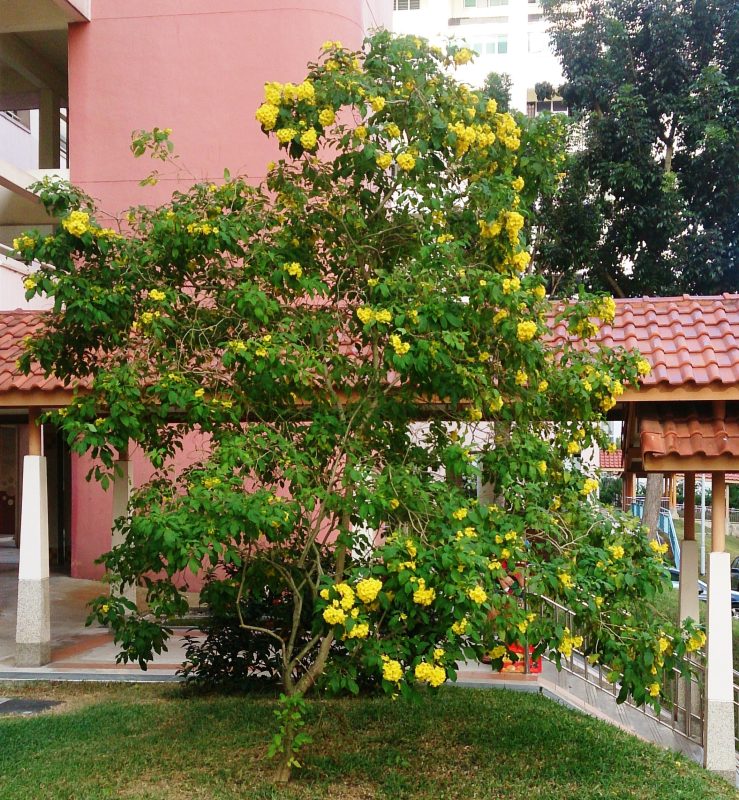
Tecoma, commonly known as Yellow or Orange Bells, is a vibrant flowering shrub that is particularly well-suited to the warm climate of Arizona. With species such as Tecoma stans (Yellow Trumpetbush) and Tecoma capensis (Cape Honeysuckle), these plants are celebrated for their showy, trumpet-like flowers that bloom in bright shades of yellow, orange, or red throughout the summer and fall.
One of the most impressive characteristics of Tecoma is its ability to attract a wide range of pollinators. The tubular flowers are specifically designed for hummingbirds, making this plant a dynamic addition to wildlife gardens. In addition to hummingbirds, the flowers also attract butterflies and bees, supporting the overall health of the ecosystem.
Tecoma plants are adaptable and thrive in well-drained soils, making them ideal choices for arid landscapes. They exhibit significant drought tolerance and can withstand hot, dry conditions common in Arizona. Once established, these shrubs require minimal care, making them excellent options for low-maintenance gardens.
In landscaping, Tecoma serves as a stunning focal point with its vibrant colors and lush foliage. The plant can grow to heights of 3 to 10 feet, depending on the species and specific growing conditions, making it suitable for hedges or as a stand-alone feature in gardens. Additionally, the attractive blooms can be complemented by other plants, enhancing the overall aesthetics of outdoor spaces.
Ulmus parvifolia (Evergreen Elm)
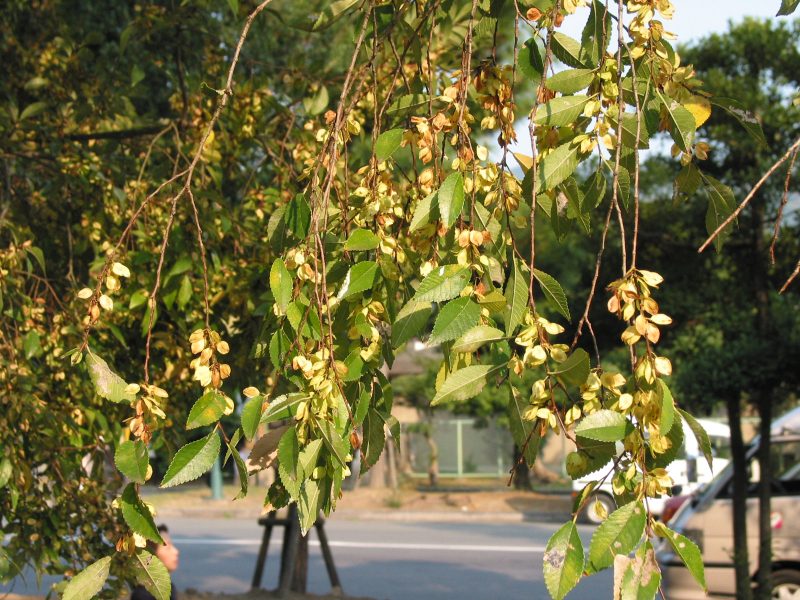
Ulmus parvifolia, commonly known as the Evergreen Elm, is a versatile deciduous tree well-suited to the climatic conditions of Arizona. Esteemed for its graceful structure and dense canopy, this tree typically reaches heights of 30 to 50 feet, making it an excellent choice for providing shade in urban and residential environments. Its glossy, dark green leaves are smaller than those of traditional elms, contributing to a refined appearance that enhances the aesthetic of any landscape.
One of the key advantages of Evergreen Elm is its exceptional drought tolerance once established. This tree can thrive in a variety of soil types, including clay, loamy, and sandy soils, and it adapts well to different pH levels. This resilience means that it can withstand the extremes of the desert climate, from intense heat to cooler winter temperatures.
A noteworthy feature of Ulmus parvifolia is its ornamental appeal. The tree boasts an attractive, mottled bark that becomes more pronounced with age, adding texture and interest to the landscape year-round. Additionally, its small, inconspicuous flowers bloom in early spring, followed by the production of tiny seeds that provide food for various bird species.
This tree is also known for its ability to improve air quality, making it a beneficial addition to urban spaces. Its broad canopy not only offers shade for cooling but also helps to reduce the urban heat island effect, making streets and neighborhoods more comfortable during the scorching summer months. Planting Evergreen Elms in public areas, parks, or residential yards can enhance the overall ecosystem while providing a beautiful, low-maintenance shade tree.
Verbena

Verbena is a vibrant, flowering perennial that thrives in the sunny Arizona desert, with several species adept at handling arid conditions. Known for its colorful clusters of small, tubular flowers, Verbena comes in a wide array of colors, including purple, pink, red, and white, creating a dazzling display that attracts pollinators such as bees, butterflies, and hummingbirds.
These plants are well-suited for water-wise landscaping, as they are remarkably drought-resistant once established. Verbena prefers well-drained soils and full sun exposure, making them ideal candidates for rock gardens, borders, or as ground cover in xeriscaped landscapes. Their sprawling growth habit allows them to fill gaps in garden beds creatively, providing a carpet of color that can last from spring through fall.
In addition to their aesthetic benefits, Verbena species are often used to create habitat for beneficial insects. The abundant nectar produced by their blooms makes them an attractive destination for pollinators, which are essential for the health of many other plants in the ecosystem. By incorporating Verbena into gardens, homeowners can support local biodiversity and contribute positively to the surrounding environment.
Verbena is relatively low-maintenance, requiring minimal watering once established. Regular deadheading can encourage more blooms, extending the flowering season and enhancing visual appeal. This resilience, coupled with a stunning display of color, makes Verbena a fantastic choice for gardeners seeking low-water, hardy plants that thrive in Arizona’s challenging conditions.
Yucca
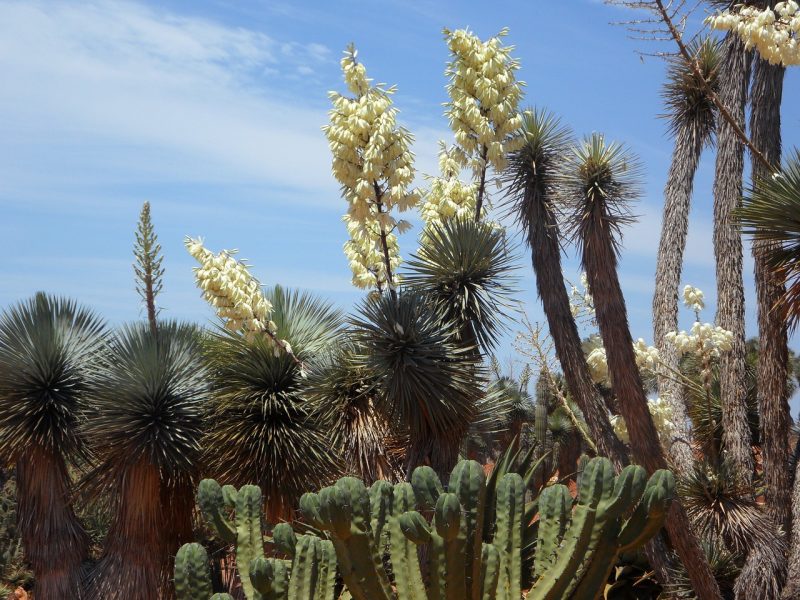
Yucca is a genus of perennial plants characterized by their striking architectural forms and distinctive rosettes of rigid, sword-shaped leaves. Various species of Yucca, including Yucca schidigera (Mohave Yucca) and Yucca brevifolia (Joshua Tree), are native to Arizona and exemplify the rugged beauty of desert ecosystems. These plants typically grow in clumps, reaching heights of 3 to 10 feet, and are known for their impressive flower stalks that can rise dramatically above the foliage, producing clusters of white or cream-colored blooms.
One of the remarkable aspects of Yucca plants is their exceptional adaptability to extreme conditions. They thrive in poor, dry soils and are highly drought-tolerant, often surviving on minimal water. This resilience makes them a staple in desert gardens and xeriscaping projects, where low water consumption is paramount.
Yucca’s unique appearance provides a strong focal point in landscaping designs. The sharp, pointed leaves can create dramatic contrasts with softer, flowering plants, enhancing visual interest. In addition to their aesthetic qualities, Yucca plants serve an ecological role by providing shelter and habitat for various desert wildlife, including birds and small mammals.
Additionally, Yucca has a rich cultural significance; Indigenous peoples of the Southwest have traditionally utilized its fibrous leaves for making ropes and textiles, while the flowers and fruits have been used in various culinary dishes. This multifaceted use of the plant highlights its importance beyond ornamental value, showcasing the deep connection between desert flora and human culture.
Valentine Bush
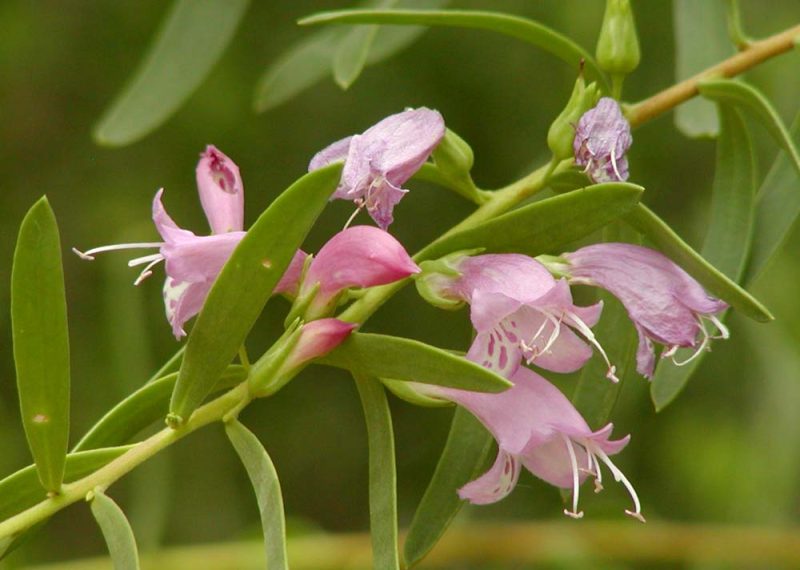
The Valentine Bush, scientifically known as Eremophila maculata, is a charismatic shrub that flourishes in the arid climates of Arizona. This evergreen plant can grow up to 3 to 6 feet tall, making it an excellent choice for creating natural privacy screens or hedges. One of the striking features of the Valentine Bush is its vibrant, reddish-pink flowers that bloom in the spring and summer, attracting a plethora of pollinators, including bees and butterflies, enhancing the local ecosystem’s vitality.
This shrub is particularly valued for its drought resistance and adaptability to poor soil conditions, making it a practical choice for water-wise gardening. Its ability to thrive in rocky or sandy soils showcases its resilience and suitability for xeriscaping projects. Additionally, the Valentine Bush requires minimal maintenance once established, allowing homeowners to enjoy its beauty without extensive care.
Beyond its ornamental use, this plant also serves an ecological purpose. The flowers provide essential nectar for hummingbirds, while its dense foliage offers shelter for various desert wildlife. The Valentine Bush is also known for its aromatic leaves, which release a pleasant scent when brushed against, adding another layer of sensory delight to gardens. Integrating this shrub into desert landscapes not only enhances visual appeal but also supports local fauna and promotes a healthy ecological balance.
Damiantia Daisy
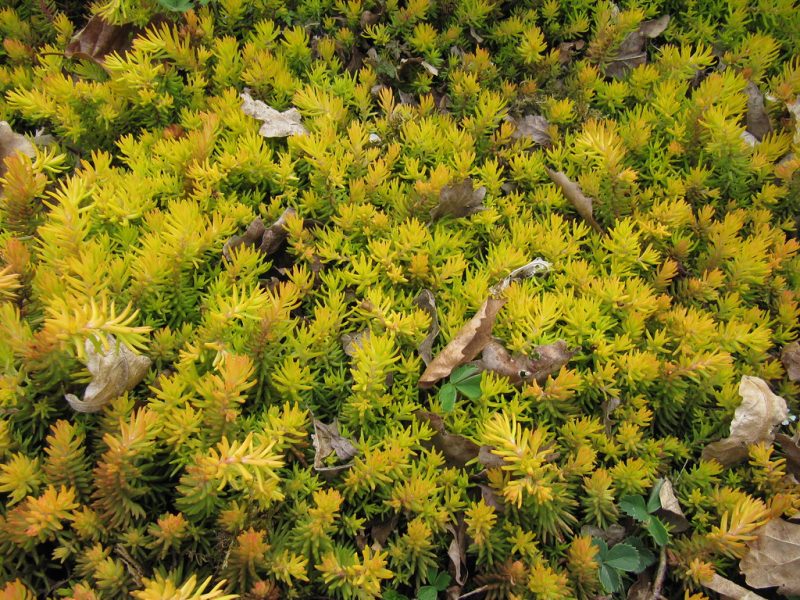
Damiantia Daisy (also spelled Damiantia daisy), known scientifically as Sedum rupestre ‘Angelina’, is a delightful perennial blooming plant native to the southwestern U.S. and Mexico. This species is particularly cherished for its cheerful yellow daisies that appear in profusion from spring to fall. The flowers offer a striking contrast against the dark green, leathery leaves, creating a vibrant display that can brighten any desert garden.
Resilient and drought-tolerant, Damiantia Daisy thrives in well-drained soils and can tolerate the harsh conditions of desert environments, including extreme heat and occasional cold snaps. This adaptability makes it an excellent choice for gardeners looking to create water-wise landscapes. Ideal for borders, rock gardens, or even as ground cover, these plants can spread and form a lush carpet of color without requiring excessive water or care.
In addition to their striking aesthetic appeal, Damiantia Daisies attract a variety of pollinators, which are vital for maintaining the health of Arizona’s ecosystems. Their long flowering season ensures a reliable source of nectar for bees and butterflies throughout much of the year. They also have a reputation for self-seeding, allowing them to spread naturally and establish themselves in various garden conditions.
Damiantia Daisy not only contributes to the visual beauty of arid landscapes but also emphasizes the importance of native plants in promoting local wildlife. Their low-maintenance nature aligns perfectly with sustainable gardening practices, making them an integral part of any landscape design that seeks to respect and reflect the unique beauty of the Arizona desert.
Claret Cup Cactus
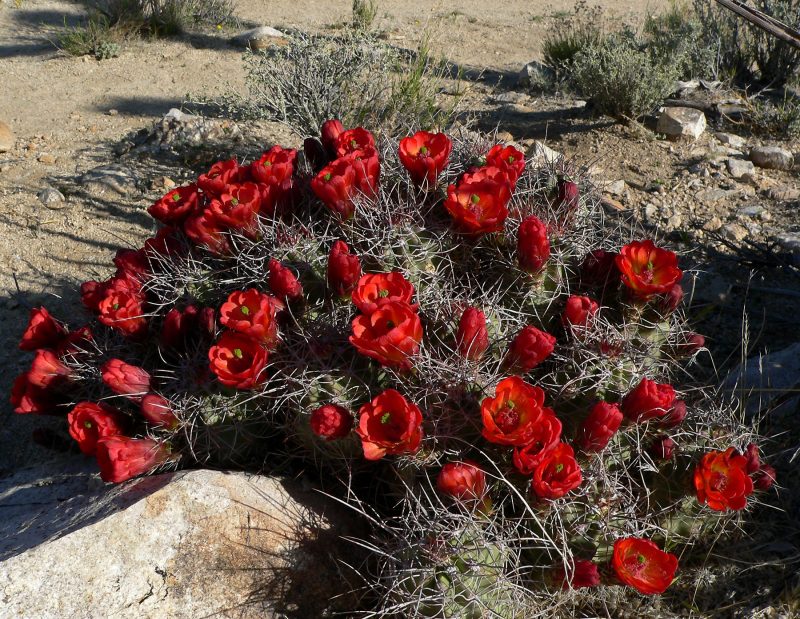
The Claret Cup Cactus, scientifically called Echinocereus triglochidiatus, is one of Arizona’s most iconic succulents, known for its striking appearance and vibrant blooms. This cylindrical cactus typically grows to about 1 to 3 feet tall and can produce multiple stems, which allows it to form impressive clusters in the landscape. The most eye-catching feature of the Claret Cup is its large, tubular flowers that emerge in spring and are often bright red or orange, resembling the colors of a deep sunset. These blooms are not just visually stunning; they are a major attractant for pollinators such as bees, butterflies, and hummingbirds.
Claret Cup Cactus is remarkably well-adapted to the harsh conditions of the desert. It thrives in rocky, well-drained soils and requires minimal water, making it a staple in xeriscape gardens. Its ability to withstand intense heat is complemented by its capacity to tolerate cold temperatures, making it suitable for a broad range of environments within Arizona.
An interesting aspect of the Claret Cup Cactus is its fruit, called “claret cups,” which forms after the flowers have been pollinated. These fruits can be edible and are often enjoyed by small mammals and birds. They are a good source of food for animals in the arid landscape, enhancing the ecological dynamics of desert habitats.
In landscaping, the Claret Cup Cactus serves as a dramatic focal point. It can be used effectively in rock gardens, as part of desert-themed borders, or even in containers. Its unique form and striking coloration can add depth and interest to any garden design, all while showcasing the beauty of native Arizona flora. By choosing Claret Cup Cactus, gardeners can create visually striking landscapes that are also ecologically beneficial.
Argentine Giant
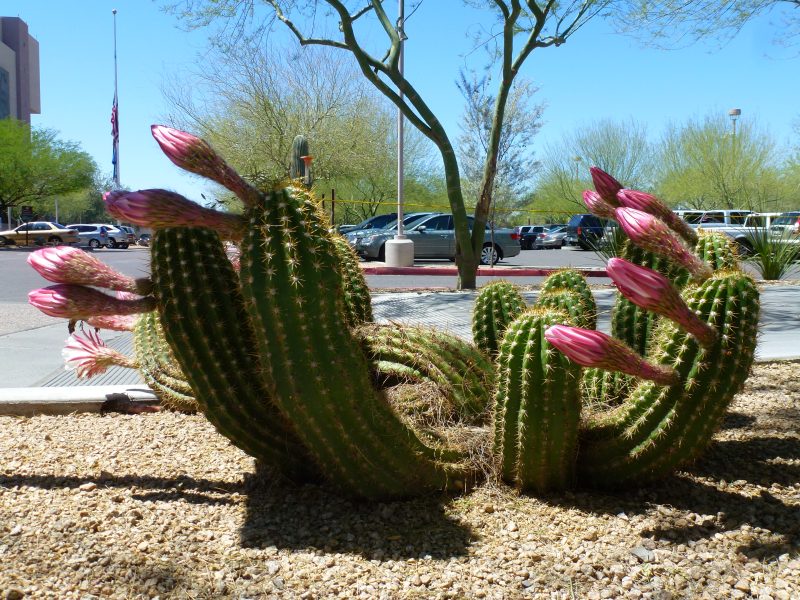
The Argentine Giant cactus, scientifically known as Echinopsis candicans, is one of the largest cacti found in desert landscapes, often reaching heights of 6 to 10 feet. This impressive columnar cactus is known for its broad, cylindrical shape adorned with prominent ribs and vibrant spines, which not only give it a striking, architectural appearance but also provide protection against herbivores in its native habitat.
In spring, the Argentine Giant dazzles with stunning, large white flowers that bloom nocturnally, often emitting a sweet fragrance that attracts pollinators such as nocturnal moths and bats. This spectacle is a true highlight of the desert landscape, creating a magical ambiance during the cool evening hours. The blooms can measure up to 6 inches in diameter and are followed by bright green fruit that adds further interest and potential food sources for local wildlife.
This species is particularly well suited for Arizona’s hot and dry conditions due to its high tolerance for drought, thriving in well-drained, sandy soils. Proper spacing is important when planting Argentine Giants, as they can grow quite large and need adequate room for their sprawling stems. From a gardening perspective, these cacti can be strategically placed to serve as dramatic focal points within succulent or xeriscape arrangements.
In addition to their stunning aesthetic qualities, Argentine Giants play an essential role in the desert ecosystem. They provide shelter for various species, including birds and small mammals, while also contributing to the biodiversity necessary for maintaining healthy ecosystems. Overall, the Argentine Giant is not just a captivating addition to gardens but also a vital component of Arizona’s natural environment.
Golden Barrel Multi Head
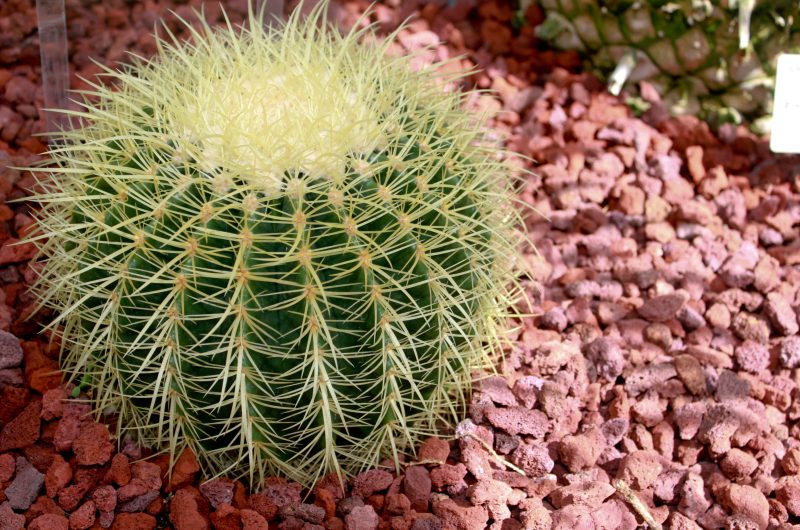
The Golden Barrel Cactus, known scientifically as Echinocactus grusonii, transforms any garden space with its round, symmetrical shape and vibrant golden spines. The multi-headed variety of this cactus can grow several heads from a single base, making it an interesting and visually appealing choice for desert landscaping. Mature specimens can reach about 2 to 3 feet in height and much wider in diameter, adding striking presence to rock gardens or succulent arrangements.
One of the exceptional qualities of the Golden Barrel Cactus is its resilience to extreme conditions. It thrives in full sun and is extremely drought-tolerant, requiring very little water once established. This adaptability makes it a favorite among gardeners looking to create low-maintenance, water-efficient landscapes. Its preference for well-drained soil also aligns well with the sandy or rocky substrates often found in Arizona.
In late spring to early summer, Golden Barrel Cactus produces stunning yellow flowers that emerge from the crown of the cactus, adding bursts of color and attracting pollinators like bees and butterflies. These blooms typically last just a few days but provide an impactful and memorable display.
Beyond aesthetics, Golden Barrel Cacti can help improve soil health in xeriscaped gardens. Their deep root systems assist in aerating the ground and preventing soil erosion. Additionally, these cacti are effective at capturing rainwater with their spiny exterior, allowing moisture to permeate into the soil efficiently.
Incorporating Golden Barrel Multi-Head varieties into desert landscapes not only enhances visual appeal but also supports local wildlife, making it an essential part of a sustainable gardening approach.
Santa Rita Prickly Pear
The Santa Rita Prickly Pear, scientifically known as Opuntia santa-rita, is a thornless variety of prickly pear cactus that stands out for its unique appearance and numerous practical uses. With its broad, paddle-like pads that can reach widths of 10 inches, this cactus is instantly recognizable, displaying vibrant colors that shift from a muted green to striking shades of purple, especially during cooler months or when exposed to sunlight.
This adaptable plant thrives in a variety of soils, making it an excellent choice for different garden settings. The Santa Rita Prickly Pear is exceptionally drought-tolerant, requiring minimal water once established. Its ability to grow in harsh conditions makes it an ideal candidate for Arizona gardens, where water conservation is a significant concern.
One of the fascinating aspects of Santa Rita Prickly Pear is its edible pads, known as “nopales,” which are valued in culinary traditions for their nutritional benefits. The fruit, called “tunas,” ripens into a sweet and flavorful treat, attracting various birds and mammals that contribute to ecological diversity. This multifunctionality enhances the appeal of the cactus, making it both a landscape feature and a source of nourishment.




